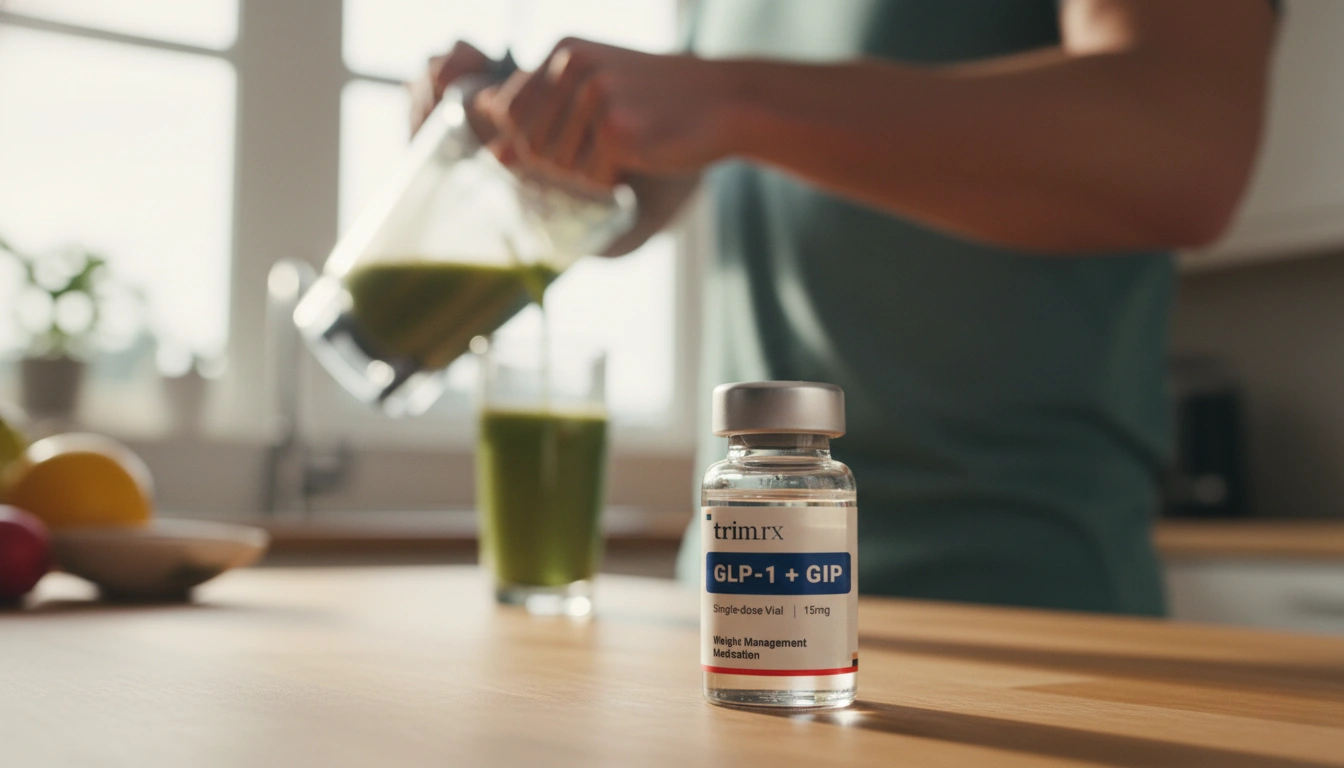Understanding the Difference Between GLP-1 and Ozempic

Introduction
Did you know that the global prevalence of diabetes has nearly doubled since 1980? This alarming statistic underscores the critical need for effective management strategies, particularly as the population ages and lifestyle factors evolve. Among the innovative solutions that have emerged in recent years, GLP-1 receptor agonists, including Ozempic, have garnered significant attention for their role in managing type 2 diabetes and facilitating weight loss.
In this blog post, we’re diving deep into the differences between GLP-1 and Ozempic, exploring their functions, mechanisms, benefits, and how they fit into the broader landscape of weight loss and metabolic health. By the end, you’ll have a comprehensive understanding of these terms, which are often used interchangeably, but represent distinct concepts in the realm of health and wellness.
We’ll also highlight TrimRx’s commitment to providing personalized weight loss solutions that incorporate the latest advancements in metabolic health. As we explore this topic, we invite you to consider how these insights might apply to your journey towards a healthier lifestyle.
What is GLP-1?
The Basics of GLP-1
Glucagon-like peptide-1, or GLP-1, is a naturally occurring hormone produced in the intestines in response to food intake. Its primary functions include enhancing insulin secretion, inhibiting glucagon release, and slowing gastric emptying, all of which contribute to better glucose regulation and appetite control. Given its multifaceted role, GLP-1 is crucial in managing metabolic health and preventing the onset of conditions such as type 2 diabetes.
Mechanisms of Action
GLP-1 operates through several mechanisms:
- Enhances Insulin Secretion: When blood glucose levels rise, GLP-1 signals the pancreas to release insulin, facilitating the uptake of glucose into cells.
- Inhibits Glucagon Release: GLP-1 suppresses glucagon, a hormone that increases blood glucose levels, thus further aiding in glucose homeostasis.
- Slows Gastric Emptying: By delaying gastric emptying, GLP-1 prolongs the feeling of fullness, which can help reduce overall caloric intake.
Lifestyle Influences on GLP-1 Levels
Interestingly, various lifestyle factors, including diet and physical activity, can influence GLP-1 secretion. Research suggests that a diet rich in fiber, healthy fats, and regular exercise can enhance the body’s ability to produce GLP-1. This underscores the importance of adopting a holistic approach to health, integrating both pharmacological and lifestyle strategies for optimal metabolic function.
What is Ozempic?
Understanding Ozempic
Ozempic is a brand name for semaglutide, a GLP-1 receptor agonist specifically designed for managing type 2 diabetes and facilitating weight loss. Approved by the FDA, Ozempic mimics the effects of GLP-1 in the body but is synthesized to provide longer-lasting benefits compared to the natural hormone.
Mechanism of Action
Ozempic works by:
- Binding to GLP-1 Receptors: It enhances the same actions as natural GLP-1, stimulating insulin secretion when glucose levels are elevated, and reducing glucagon secretion.
- Slowing Gastric Emptying: Similar to GLP-1, Ozempic slows down how quickly food leaves the stomach, which helps control appetite and prolongs satiety.
Clinical Applications
Ozempic is primarily used in two contexts:
- Diabetes Management: It helps regulate blood sugar levels, making it a vital component of diabetes treatment plans.
- Weight Loss: Ozempic is also prescribed for weight management in individuals who are overweight or have obesity, especially when coupled with lifestyle modifications.
Key Differences Between GLP-1 and Ozempic
While both GLP-1 and Ozempic are pivotal in managing metabolic health, they are fundamentally different entities. Here are the primary distinctions:
Origin
- GLP-1: A naturally occurring hormone produced by the body.
- Ozempic: A synthetic medication designed to replicate and enhance the effects of GLP-1.
Functionality
- GLP-1: Functions endogenously to regulate insulin and glucagon levels, impacting blood glucose control naturally.
- Ozempic: Acts as a pharmacological agent that mimics GLP-1, providing a more prolonged effect and is specifically formulated for use in diabetes and weight management.
Administration
- GLP-1: Naturally released in response to food intake, with levels fluctuating based on dietary habits and lifestyle.
- Ozempic: Administered as a weekly injection, allowing for consistent dosing and effects over time.
Clinical Use
- GLP-1: Essential for understanding metabolic health but not used as a standalone treatment.
- Ozempic: Prescribed as a treatment option for managing type 2 diabetes and aiding in weight loss, often as part of a comprehensive care plan.
The Role of TrimRx in Weight Loss Management
At TrimRx, our journey began with a mission to empower individuals to embrace healthier lifestyles through innovative weight loss solutions. By merging cutting-edge telehealth technology with personalized care, we strive to make sustainable weight loss attainable for everyone.
Our approach includes:
- Personalized Assessments: We offer a free assessment quiz that helps individuals determine their eligibility for prescription medications like Ozempic and other GLP-1 receptor agonists. This ensures that every treatment plan is tailored to the individual’s unique health needs.
- Medically Supervised Care: Our platform provides compassionate, medically supervised guidance throughout the weight loss journey. We believe that everyone deserves personalized attention and care.
- Comprehensive Support: Beyond medication, we offer lab work, ongoing consultations, and unlimited support to ensure that our clients are well-equipped to succeed on their weight loss journey.
If you’re considering a weight loss program, we encourage you to take our free assessment quiz here.
Integrating GLP-1 and Ozempic into Your Weight Loss Journey
Benefits of GLP-1 Receptor Agonists
GLP-1 receptor agonists, including Ozempic, have demonstrated impressive results in both diabetes management and weight loss. Here are some of the notable benefits:
- Improved Blood Sugar Control: Research indicates that these medications can significantly lower A1C levels in individuals with type 2 diabetes.
- Weight Loss: Patients often experience substantial weight loss, which is associated with reduced risk factors for chronic diseases.
- Reduced Appetite: By enhancing satiety signals, GLP-1 receptor agonists help individuals eat less without feeling deprived.
Safety and Side Effects
As with any medication, it’s crucial to consider potential side effects. Common side effects associated with GLP-1 receptor agonists include:
- Nausea
- Vomiting
- Diarrhea
- Constipation
While these side effects can be uncomfortable, many patients find them manageable. It’s important to work closely with healthcare providers to monitor and address any adverse reactions.
Lifestyle Factors Supporting GLP-1 Function
In addition to pharmacological interventions, lifestyle choices play a pivotal role in maximizing GLP-1 levels and overall metabolic health. Here are some strategies:
- Dietary Adjustments: Incorporating fiber-rich foods, healthy fats, and lean proteins can enhance GLP-1 secretion. Foods such as avocados, legumes, and whole grains are excellent choices.
- Regular Physical Activity: Engaging in moderate exercise not only supports weight loss but also increases the body’s ability to produce GLP-1.
- Stress Management: Chronic stress can negatively impact metabolic health; incorporating mindfulness and relaxation techniques can be beneficial.
Conclusion
Understanding the difference between GLP-1 and Ozempic is crucial for navigating the complexities of diabetes management and weight loss. While GLP-1 is a natural hormone essential for metabolic regulation, Ozempic is a powerful synthetic medication that mimics its effects to provide extended benefits.
At TrimRx, we are dedicated to supporting your weight loss journey through personalized care and medically supervised programs. Whether you’re considering prescription medications or looking for lifestyle changes to enhance your health, our team is here to guide you every step of the way.
If you’re interested in exploring how our weight loss solutions can work for you, we invite you to take our free assessment quiz here and discover your personalized path to a healthier lifestyle.
FAQ
What is the primary difference between GLP-1 and Ozempic?
GLP-1 is a natural hormone produced in the body, while Ozempic is a synthetic medication that mimics GLP-1 to manage diabetes and support weight loss.
How does Ozempic help with weight loss?
Ozempic promotes weight loss by enhancing insulin secretion, reducing glucagon levels, and slowing gastric emptying, which leads to increased feelings of fullness.
Are there side effects associated with GLP-1 receptor agonists?
Yes, common side effects include nausea, vomiting, and diarrhea. However, many patients find these side effects manageable.
How can lifestyle changes complement GLP-1 medications?
Incorporating a healthy diet, regular exercise, and stress management techniques can enhance the effectiveness of GLP-1 medications and improve overall metabolic health.
How can I start my weight loss journey with TrimRx?
You can begin by taking our free assessment quiz here to determine your eligibility for personalized treatment options.

Transforming Lives, One Step at a Time
Keep reading
Vitamin B12 and GLP-1 Medications: What to Know
GLP-1 medications can lower B12 absorption and intake; learn symptoms, food sources, supplement options, and how to monitor levels.
Semaglutide Injection Site Reactions: What To Know
Learn why semaglutide injections can cause redness, swelling or nodules, how to prevent and treat them, and when to seek medical care.
TrimRx vs Friday’s
Compare TrimRx and Friday’s telehealth GLP-1 weight-loss programs: pricing, medical support, coaching, delivery, and which fits your needs.



